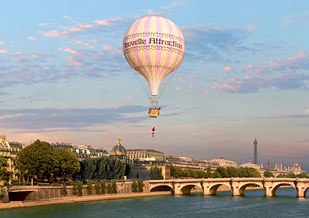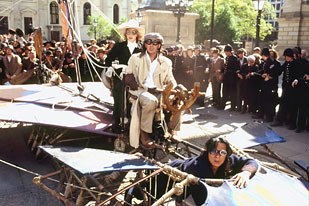Henry Turner travels around the world to discover the vfx wonders that lie within Disney and Walden Medias remake of Around the World in 80 Days.

The new Around the World in 80 Days is reworked on a more modest scale than the original 1956 Mike Todd production, the film for which Todd AO 70mm was invented, and which brought together David Niven, Cantiflas and Shirley MacLaine. That film was inspired by Orson Welles stage musical version of the Jules Verne novel, which ran on Broadway briefly, with songs by Cole Porter, and magic tricks by Welles himself, in the starring role of Phileas Fogg, the gambling globetrotter, portrayed in the remake by Steve Coogan. (Coincidentally, Welles 1938 radio version of Around the World was the show just one week prior to his War of the Worlds broadcast that panicked America.)
Obviously the world has shrunk a bit, and foreign locations no longer have as much exotic allure for audiences. Hence the new film is mainly a comic romp, showcasing Jackie Chans considerable talents. Part of the popularity of the Todd best picture Oscar winner came from the use of cameo performances, featuring stars such as Frank Sinatra and Marlene Dietrich in bit parts. In an homage to the classic, the new Around the World features numerous cameos, among them Arnold Schwartzeneggers last performance on the big screen before he became governor of California.
Steamboats and Flying Machines
On their journey, Chan and Coogan have to make their way around the globe in various contraptions, some realistic, while others are zany imaginary vehicles, such as a flying machine. The bulk of the effects work on the film was done to create the vehicles, along with CG stars and extras to ride in them.
Derek Spears of Rhythm & Hues was visual effects supervisor on the production. He joined the film after previs on key sequences was completed, giving him a guide to the final work. The balloon ride sequence and the steamer ship sequence, which included the bit with the flying machine as well, those were prevised, allowing us to find out the blocking and location for the sets. The previs that was really useful was the one where we had to build a CG paddle steamer. Previs helped us decide how we were going to shoot the plate, which included a live-action tugboat to make the water wake for our steamer, and guided us in deciding how fast it should move and how to frame it, which allowed the director to buy off on that before it was shot.
Populating the World
Naturally, the film required a cast of thousands something made more affordable with todays technology. We did motion capture for a lot of our background characters. We did maybe four or five shots of background crowds, and all the walk cycles were done with motion capture. On the deck of the ship all the sailors were motion captured. However, for our key actors for Jackie Chan and Steve Coogan, they are actually hand-animated for specific action or stunts. Though Chan still handles most of his action and fight scenes as he did in his Hong Kong days, hanging off a balloon miles high in the air was luckily not part of his contract!
Spears used a number of systems to get the necessary results. For animation we have our internal software called Voodoo, for rendering we used two different paths. For the steamer ship and water we used Houdini, and for clouds and all the rest of our shots we used our internal renderer called Rend. We used our internal compositor called IC, we also used Inferno in some of the shots.

Around the World relies mainly on humor and characterization. Hence the shot count is not nearly as high as in other summer blockbusters. Spears says his work on the film used familiar techniques, with an effort to make them look fresher than before. We didnt do a lot of groundbreaking new things, we did a lot of things we knew how to do and tried to extend them and find better ways to do them.
Colorful Descisions
As a Disney release, one can expect a colorful approach to both the storytelling and the actual look of the story. Spears says that while his work was mainly photorealist in design, the color palette used in the production art design is very colorful. So its photoreal within that palette, which has a very playful, cartoonish look to it in some places.
CG Locations
While most of the film was shot on location in Europe and Asia, some locations were created digitally. Theres a shot we created in London where we see the balloon flying over the river Seine, which was done using a collection of still photos that I took in Paris, and then we made a matte painting out of them, added digital extras, CG water and the balloon. It was synthetic in that there was no motion picture camera used at all. There were also some shots over the Atlantic Ocean that were entirely synthetic. We never actually shot in London, but I shot aerial plates in London, in which we heavily replaced various elements, to make them look more period.
Not For Mature Audiences Only
Spears points out that the film is a great vehicle for Chan, who has excellent chemistry with co-star Coogan. But instead of being the fun-for-all-ages spectacle of the Todd classic, he describes the new Around the World as more targeted to a childrens audience. So if you have kids, take them!
Painting a Flying Machine
The London-based effects house Cinesite also contributed to the movie. visual effects producer Cath Duncan points out one key 3D shot Cinesite created that was fairly unusual. The shot was filmed live-action an establishing shot where the camera pulls back to reveal a ship carrying a mythic Flying Machine a19th century wooden construction with plain white sails. But due to a recut, the story called for the Flying Machine to have been hand painted with a bird and wings design. So we tracked the scene in Matchmover and used a Maya model to track the Flying Machine and apply a texture to the painted areas. The irregular handmade nature of the Flying Machine and the extreme camera move made this a tricky shot.
Some Final Touches
Sophie Trainor, pr and marketing manager of The Moving Picture Co., gives a rundown on her companys work on the film: The key scenes contributed by MPC were the balloon sequence in Paris where Jackie Chan and Steve Coogan are dragged along by the balloons rope. During the course of this adventure they encounter numerous comedic mishaps before finally managing to reach safety in the balloon. Secondly, in a similar style sequence the same pair encounters problems with an elephant. We also did wire removals and set extensions to approximately 50 shots on the film, and successfully undertook 65 wire removals and comps for the films marketing trailer in a staggeringly short two-week period. MPC used Shake and Inferno on shots for the film.
Henry Turner is a writer and award-winning filmmaker, whose Lovecraft-inspired horror feature, Wilbur Whateley, won top awards at the Chicago International Film Festival. His writing on film has appeared in the Los Angeles Times, Lecran Fantastique, Variety and many other publications. A longtime film festival executive, he has programmed for the Slamdance Film Festival, and currently heads FilmTraffick L.A.







